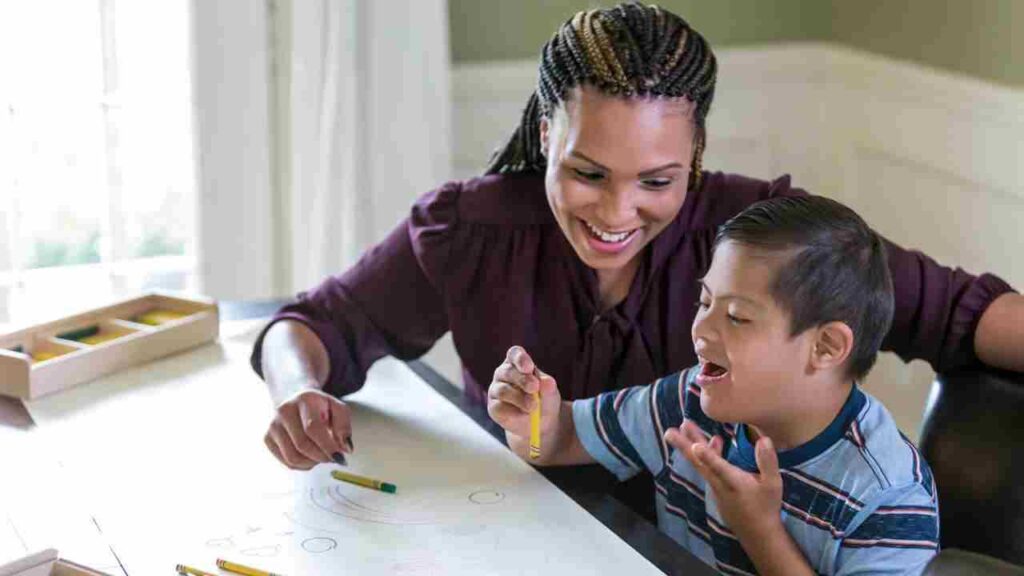In today’s inclusive educational landscape, it is essential to ensure that children with genetic syndromes receive the support they need to thrive academically, socially, and emotionally. Genetic syndromes encompass a wide range of conditions caused by an alteration or mutation in one or more genes.
These syndromes can present unique challenges that require specific strategies to create an inclusive learning environment. This article will explore effective ways to support children with genetic syndromes in school, promoting their educational success and overall well-being.
Genetic Syndromes
Before delving into the strategies for supporting children with genetic syndromes, it’s important to have a basic understanding of these conditions. Genetic syndromes can manifest in various ways, affecting physical, cognitive, and behavioral aspects of a child’s development.
Some common genetic syndromes include Down syndrome, Fragile X syndrome, Turner syndrome, and Prader-Willi syndrome, among others. Each syndrome presents its own set of challenges and strengths, and it’s crucial to approach support with an individualized approach.
Read also: Special Need Kids: Types, Overview, and Definitions
Creating an Inclusive Environment
 Emphasize Person-First Language: When interacting with children with genetic syndromes, it’s crucial to use person-first language that puts the individual before their condition. For example, instead of saying “a Down syndrome child,” say “a child with Down syndrome.” This approach promotes inclusivity and recognizes the child’s identity beyond their syndrome.
Emphasize Person-First Language: When interacting with children with genetic syndromes, it’s crucial to use person-first language that puts the individual before their condition. For example, instead of saying “a Down syndrome child,” say “a child with Down syndrome.” This approach promotes inclusivity and recognizes the child’s identity beyond their syndrome.- Develop Individualized Education Plans (IEPs): Collaborate with educators, parents, and specialists to develop comprehensive IEPs tailored to the child’s specific needs. These plans should outline academic goals, accommodations, and any necessary support services. Regular review and communication with all stakeholders are essential for ensuring the child’s progress.
- Supportive Classroom Environment: Foster an inclusive classroom environment where all students feel valued and respected. Encourage peer interactions, empathy, and understanding. Educate classmates about genetic syndromes to promote acceptance and reduce stigma. Utilize visual aids, adaptive equipment, and assistive technology to support diverse learning styles.
Read also: Supportive Home Environment For A Down Syndrome Child
Tailoring Instruction and Assessment
- Differentiated Instruction: Implement teaching strategies that accommodate diverse learning styles and abilities. Provide materials in multiple formats, such as visual, auditory, and kinesthetic. Break down complex concepts into smaller, manageable parts, and provide step-by-step instructions.
- Modifications and Accommodations: Offer modifications and accommodations based on individual needs. These can include extended time for assignments and assessments, simplified instructions, and alternative methods for demonstrating understanding. Ensure that the child has access to necessary support services, such as speech therapy or occupational therapy.
- Multisensory Learning: Engage children with genetic syndromes through multisensory learning experiences. Incorporate visual aids, hands-on activities, music, and movement to enhance their understanding and retention of information. Encourage creativity and self-expression in assignments and projects.
Collaborating with Support Professionals
- Engage Special Education Teachers: Collaborate closely with special education teachers who possess expertise in supporting children with genetic syndromes. Regularly communicate and share strategies to address the child’s specific needs. Work together to adapt curriculum materials and modify instructional approaches.
- Involve Speech and Language Therapists: Many children with genetic syndromes may experience speech and language challenges. Consult and collaborate with speech and language therapists to develop strategies for improving communication skills. Implement these strategies consistently across all educational settings.
Read also: How to Support Children with Social-Emotional Needs
Promoting Social Inclusion
 Encourage Peer Relationships: Foster opportunities for children with genetic syndromes to interact and build relationships with their peers. Promote inclusive activities, such as group projects and cooperative learning, where students can collaborate and learn from one another. Teach empathy and encourage classmates to be supportive and inclusive.
Encourage Peer Relationships: Foster opportunities for children with genetic syndromes to interact and build relationships with their peers. Promote inclusive activities, such as group projects and cooperative learning, where students can collaborate and learn from one another. Teach empathy and encourage classmates to be supportive and inclusive.- Buddy Systems: Implement a buddy system where students with genetic syndromes are paired with supportive classmates. This helps create a sense of belonging and provides additional support during classroom activities and transitions. Encourage buddies to assist with academic tasks, social interactions, and navigating the school environment.
- Social Skills Development: Offer social skills training to help children with genetic syndromes develop effective communication, social cues, and problem-solving abilities. Incorporate role-playing, modeling, and real-life scenarios to teach appropriate social behavior. Provide opportunities for socialization through structured group activities and clubs.
Supporting Emotional Well-being
- Emotional Support: Recognize and address the emotional needs of children with genetic syndromes. Create a safe and supportive environment where they can express their feelings and concerns openly. Establish regular check-ins to assess their well-being and offer guidance or counseling services if necessary.
- Self-esteem Building: Celebrate the strengths and achievements of children with genetic syndromes to boost their self-esteem. Provide positive feedback and recognition for their efforts. Encourage them to participate in activities where they can showcase their talents and abilities.
- Collaboration with Mental Health Professionals: Collaborate with school counselors, psychologists, or mental health professionals to provide additional support for children with genetic syndromes. These professionals can offer counseling services, develop coping strategies, and help address any emotional or behavioral challenges.
Read also: Strategies for Helping Children with Communication Difficulties
(Frequently Asked Questions)
Can children with genetic syndromes attend regular schools?
Yes, children with genetic syndromes can attend regular schools with appropriate support and accommodations. Inclusion in mainstream educational settings benefits their social development and fosters acceptance and understanding among their peers.
Are there specific teaching strategies for children with genetic syndromes?
Yes, teachers can use differentiated instruction, multisensory learning, and individualized education plans to cater to the diverse learning needs of children with genetic syndromes. It’s important to adapt teaching methods based on each child’s abilities and strengths.
How can parents collaborate with schools to support their child with a genetic syndrome?
Parents should establish open communication with teachers and school administrators to discuss their child’s needs, share information about their genetic syndrome, and collaborate on creating effective support plans. Regular meetings and updates help ensure the child’s progress.
What role do assistive technologies play in supporting children with genetic syndromes?
Assistive technologies, such as speech-to-text software, text-to-speech programs, and adaptive devices, can enhance communication, accessibility, and learning opportunities for children with genetic syndromes. These tools help level the playing field and promote independence.
Conclusion
In conclusion, supporting children with genetic syndromes in school requires a comprehensive and individualized approach. By creating an inclusive environment, tailoring instruction and assessment, collaborating with support professionals, promoting social inclusion, and supporting emotional well-being, educators can empower these students to reach their full potential. It is crucial to recognize the unique strengths and challenges associated with each genetic syndrome and provide the necessary support and accommodations for their academic and social success.


 Emphasize Person-First Language: When interacting with children with genetic syndromes, it’s crucial to use person-first language that puts the individual before their condition. For example, instead of saying “a Down syndrome child,” say “a child with Down syndrome.” This approach promotes inclusivity and recognizes the child’s identity beyond their syndrome.
Emphasize Person-First Language: When interacting with children with genetic syndromes, it’s crucial to use person-first language that puts the individual before their condition. For example, instead of saying “a Down syndrome child,” say “a child with Down syndrome.” This approach promotes inclusivity and recognizes the child’s identity beyond their syndrome. Encourage Peer Relationships: Foster opportunities for children with genetic syndromes to interact and build relationships with their peers. Promote inclusive activities, such as group projects and cooperative learning, where students can collaborate and learn from one another. Teach empathy and encourage classmates to be supportive and inclusive.
Encourage Peer Relationships: Foster opportunities for children with genetic syndromes to interact and build relationships with their peers. Promote inclusive activities, such as group projects and cooperative learning, where students can collaborate and learn from one another. Teach empathy and encourage classmates to be supportive and inclusive.




